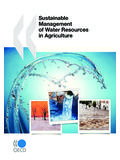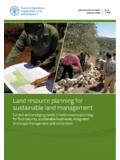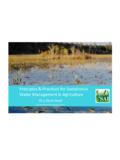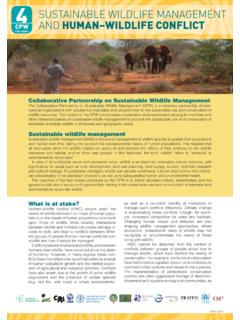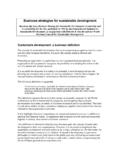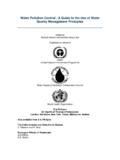Transcription of Sustainable Land Management - World Bank
1 A G R I C U LT U R E A N D R U R A L D E V E L O P M E N T. Sustainable land Management CHALLENGES, OPPORTUNITIES, AND TRADE-OFFS. Sustainable land . Management . Sustainable land . Management . Challenges, Opportunities, and Trade-offs THE World BANK. Washington, DC. 2006 The International Bank for Reconstruction and Development/The World Bank 1818 H Street, NW. Washington, DC 20433. Telephone 202-473-1000. Internet E-mail All rights reserved. 1 2 3 4 :: 09 08 07 06. This volume is a product of the staff of the International Bank for Reconstruction and Development / The World Bank. The findings, interpretations, and conclusions expressed in this volume do not necessarily reflect the views of the Executive Directors of The World Bank or the governments they represent.
2 The World Bank does not guarantee the accuracy of the data included in this work. The boundaries, colors, denominations, and other information shown on any map in this work do not imply any judgment on the part of The World Bank concerning the legal status of any territory or the endorsement or acceptance of such boundaries. Rights and Permissions The material in this publication is copyrighted. Copying and/or transmitting portions or all of this work without permission may be a violation of applicable law. The International Bank for Reconstruction and Development / The World Bank encourages dissemination of its work and will normally grant permission to reproduce portions of the work promptly.
3 For permission to photocopy or reprint any part of this work, please send a request with complete information to the Copyright Clearance Center Inc., 222 Rosewood Drive, Danvers, MA 01923, USA; telephone: 978-750-8400; fax: 978-750-4470; Internet: All other queries on rights and licenses, including subsidiary rights, should be addressed to the Office of the Publisher, The World Bank, 1818 H Street NW, Washington, DC 20433, USA; fax: 202-522-2422; e-mail: ISBN-10: 0-8213-6597-5 e-ISBN: 0-8213-6598-3. ISBN-13: 978-0-8213-6597-7 DOI: Library of Congress Cataloging-in-Publication Data has been applied for. CONTENTS. Tables, Figures, and Boxes vii Acknowledgments ix Acronyms and Abbreviations xi Overview xiii 1.
4 Introduction 1. 2. Incidence and Effects of land Degradation 5. Changing land Use: Its Causes and Implications 10. Global Environmental Change 16. 3. Challenges to Sustainable land Management 18. Appropriate land Management Systems 18. Improved Water Management 22. Adapting to Climate Change 24. Knowledge Dissemination and land Policy Constraints 27. 4. SLM Interventions: An Agri-technical Perspective 31. Protecting the land Resource: Agricultural Intensification and Integrated Farming Systems 34. Soil Fertility Management 35. Market Opportunities Linked to Erosion Control Practices: A Key to Adoption? 37. Protecting and Managing Watersheds 39.
5 Exploiting the Production and Environmental Service Functions of land 42. v 5. The Bank's Evolving SLM Portfolio 50. Past and Current Investments for SLM and Related Interventions 50. The Pattern of Bank Group Investments in SLM, NRM, BioCarbon, and Watershed Management Programs 51. Lessons Learned 57. 6. SLM: Strategic Options 59. Policy and Sector Work 59. Research and Technology Development 60. Knowledge Sharing and Extension 63. Providing Incentives, Expenditure Priorities, and Modes of Financing 66. Recommended Approach and the Role of the World Bank Group 67. Appendix: land Management and a Useful Plant Diversity Index ( V Index) 70.
6 Notes 73. Bibliography 75. Index 83. vi CONTENTS. TA B L E S , F I G U R E S , A N D B O X E S. Tables Organizing Framework for Technical Aspects of land and Natural Resource Management at the Watershed Level 41. Economic Valuation Techniques for PES 46. Summary of SLM Strategies Implemented across Sectors 52. Selected Examples of Investments for Watershed Management Programs in Different Regions: World Bank Watershed Management Projects (1990 2004) 55. The ASB Matrix 60. Figures The DPSIR Framework for Assessing land Degradation and SLM. Intervention Points 7. Global Food Production, Food Price, and Total Number of Undernourished People (1991 2003) 9.
7 Agricultural Expansion and Deforestation 15. Five Broad Clusters of Forces Driving Tropical Deforestation and land Degradation 20. vii Effects of land and Water Management at the Watershed Level 40. Actual World Bank Lending by Region for Sustainable Natural Resource Management Projects with More Than 25 Percent of Total for SLM 53. BioCarbon Projects by Region 56. Carbon Value of BioCarbon Projects by land Management Category 56. Relationship between land Use Type, Plant Biodiversity, and Oil Palm Tenure, Jambi, Sumatra 71. Relationship between land Use Type, Plant Biodiversity, and Age of Oil Palm Plantation, Jambi District, Sumatra (Indonesia) 72.
8 Relationship between Employment and Plant Biodiversity, Jambi, Sumatra 72. Boxes Ecosystem Services 6. land Use Dynamics in the Cerrado (Brazil) and the Miombo (Southern Africa) 16. Blue and Green Water Management for SLM and Enhanced Productivity 23. SLM and Enhancing Water Productivity 25. Projected Country-Level Effects of Climate Change on Rain-Fed Cereal Production (IPCC 2001) 26. A Vision for Improved land and Water Management in Rural Landscapes 34. Linking Income-Earning and Cost-Saving Opportunities to Soil Conservation Practices and Control of Pollution and Sedimentation 39. Assessing Whether Forests and Reforestation Are Beneficial for Hydrology and Groundwater Recharge 43.
9 Madagascar's Protected Areas and Payments for Environmental Services 48. viii TABLES, FIGURES, AND BOXES. AC K N OW L E D G M E N T S. The preparation of this report was managed by the Agriculture and Rural Devel- opment (ARD) Department. Erick Fernandes and Richard Burcroff wrote the report with substantive contributions from Jonathan Anderson, Malcolm Blackie, Mustapha Ceesay, Enos Esikuri, Andrew Gillison, Nteranya Sanginga, Eric Smaling, and Erika Styger. The authors are grateful for constructive comments and suggestions from the peer reviewers: Shawki Bhargouti, Aziz Bouzaher, Guy Evers (FAO), Nadim Khouri, James Smyle, and Mark Wilson.
10 Many others provided inputs, includ- ing Tom Tomich (ICRAF), Steve Vosti (UC Davis), Gerhard Dieterlhe, Salah Darghouth, and Severin Kodderitzsch, as well as Melissa Williams, Marisa Baldwin, and Sarian Akibo-Betts. Kevin Cleaver and Sushma Ganguly provided strong support throughout the development of this report and helped focus the scope of the document. The report is intended to support the efforts of the development community and national stakeholders to better integrate land and natural resource man- agement approaches to improve rural livelihoods and reduce poverty. ix A C R O N Y M S A N D A B B R E V I AT I O N S.










